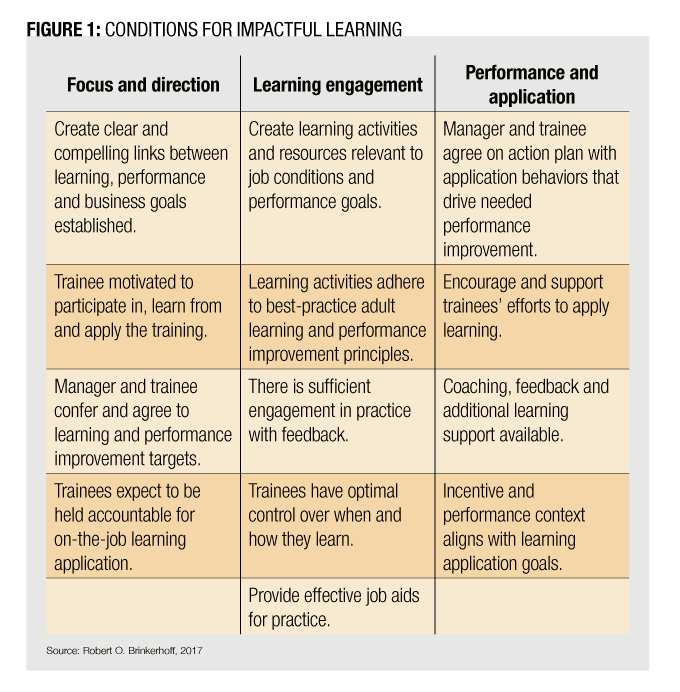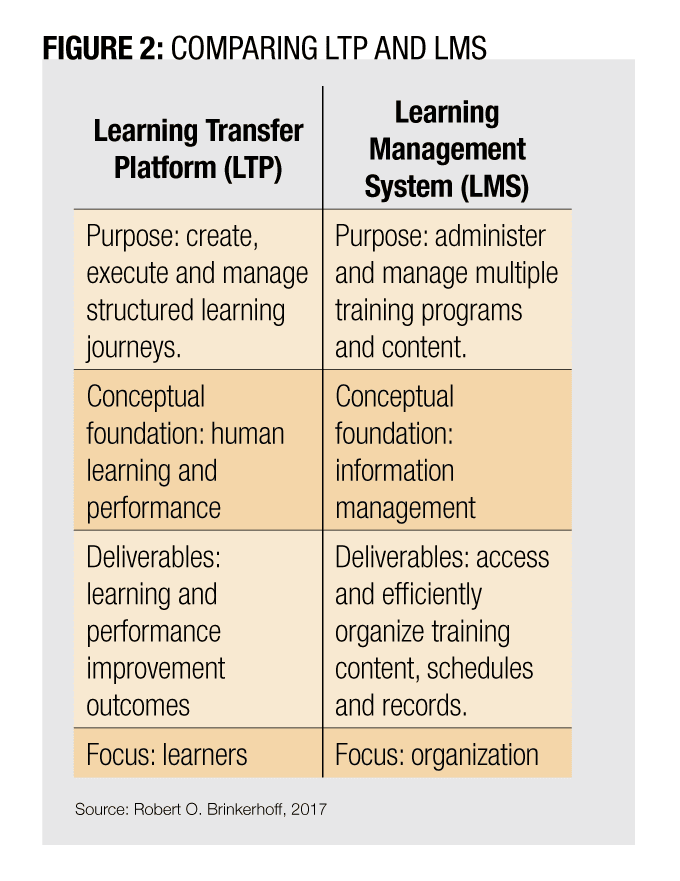 Learning and development leaders have been barraged for years with a distressing truth: Most training does not work. “For the most part, learning does not lead to better organizational performance, because people soon revert to their old ways of doing things” according to “Why Leadership Training Fails — and What to Do About It,” an article in the October 2016 issue of Harvard Business Review. Past research on training effectiveness, and dozens of impact evaluation studies over the past 30 years, indicate only about 20 percent of training results in improved job performance for managers and leaders.
Learning and development leaders have been barraged for years with a distressing truth: Most training does not work. “For the most part, learning does not lead to better organizational performance, because people soon revert to their old ways of doing things” according to “Why Leadership Training Fails — and What to Do About It,” an article in the October 2016 issue of Harvard Business Review. Past research on training effectiveness, and dozens of impact evaluation studies over the past 30 years, indicate only about 20 percent of training results in improved job performance for managers and leaders.
But emerging technological innovations called learning transfer platforms, or LTPs, have demonstrated a capability — when designed according to high-impact learning principles – to significantly improve the impact of learning investments.
What is an LTP?
An LTP is a cloud-based software platform that wraps custom-designed interactions and learners’ engagements around and into more traditional employee development workshops and seminars. This creates a learning/performance improvement journey for each participant.
The journey process is embedded in the web-supported platform, digitally managed and tracked from start to finish, and accessible from computers or mobile devices. A participant’s first contact with the program is an email or text with a URL link to the platform. Then the platform takes over and drives each individual learner’s engagement, assigning and monitoring tasks and activities over an extended period — from weeks to months to potentially more than a year’s time.
Manager engagement and structured social interaction with other learners support each participant’s learning/performance improvement journey. All task assignments, except scheduled group workshop interventions, can be accomplished on participants’ own schedules at their most convenient and impactful times.
When properly designed, a learning/performance improvement journey will reflect the key best-practice principles of high-impact learning using activities that will create the conditions summarized in Figure 1.
 “Bringing together different parts of a blended program into a single platform and bringing in … the learner’s manager are key wins for us in using an LTP,” said Peter Sheppard, global head of learning excellence at Ericsson. “A tool that supports from start to finish in the learning process I’ve always thought essential for realizing the investment in key learning programs.”
“Bringing together different parts of a blended program into a single platform and bringing in … the learner’s manager are key wins for us in using an LTP,” said Peter Sheppard, global head of learning excellence at Ericsson. “A tool that supports from start to finish in the learning process I’ve always thought essential for realizing the investment in key learning programs.”
Why LTP Technology Works
It’s tried and true: Learning is a process, not an event. Learning leaders have been practicing time-extended leadership development programs for years that include many of the components found in an LTP supported program, including e-learning and workshop instruction and cohort team projects.
But these extended-time and blended-learning programs have achieved only moderately improved results. While better than their event-only antecedents, few work as well as their organization sponsors need them to. While learning/performance improvement journeys can be designed and managed without an LTP, it is challenging and time-consuming on a small scale, and difficult if not impossible to upscale this approach to large numbers of participants across multiple organizational settings with differing language capabilities. But learning leaders should recognize that LTPs are not meant to replace LMSs. Each platform has differing capabilities and serves different though complementary purposes (see Figure 2).
“For many years, we … were challenged with driving and measuring greater results from our training,” said Merete Hanssen, head of Volkswagen’s training academy in Sweden. “Our LMS systems were helping us be more efficient and improve our training administration, but did not help us leverage greater impact from our programs. Now that we have an LTP capability, our training participants have and are using more follow-up tools. This is leading to more on-the-job application of the targeted behaviors we were after, and we can measure and demonstrate the difference.”
LTP approaches succeed for tactical and strategic reasons. These programs can achieve behavioral change at improved rates — often for 80 percent and more of participants — matching other types of high-impact learning initiatives; but they do so more consistently, with more participants, with greater ease of administration than their labor-intensive, non-LTP counterparts. At the tactical level, they advance learning practice because:
The software makes high-impact learning design and execution easier for all.
LTP programs are often cheaper and more cost-effective. They remove knowledge foundation building and cohort social familiarization from workshop time, allowing these costly interventions to focus entirely on skill practice, role-play and feedback. In many cases, LTP users can reduce workshop time and their concomitant costs by 1/3 or more.
LTP program participants are more likely to engage in learning and on-the-job application activities. They often find the thoughtfully scaffolded learning tasks easier and more convenient to complete, allowing time for absorption and feedback. Secondly, they report feeling more accountability for learning and application because of transparent tracking and social network engagement and feedback because with the platform, there is no place to hide.
- Participants are more motivated to learn and apply that learning, since they have a chance to forecast and to believe in a journey that is easy to start, and has clear goals that address their social, individual advancement and job performance expectations.
- Finally, the entire process is infinitely scalable, allowing successful application for a small cohort or thousands of participants spread across the globe. For instance, an LTP could use the same program translated into 25 or more languages.
Measurement and Evaluation is Vital
Strategically, LTP approaches help address the perennial challenges of driving change and accelerating execution of strategic initiatives. Many of the current management and culture systems learners return to post-training largely overwhelm sustained behavioral change; learning seeds need fertile organizational soil in which to grow.
Learning and systems change efforts can and should be conducted in parallel. For important strategic change, waiting to make the systems changes needed before training can threaten competitive advantage and organization survival. With major strategic change, training is often a necessary catalyst, providing the competencies needed for execution; waiting for the system to be fully changed likely will take longer than the strategy’s shelf life.
LTP technology produces needed competencies faster, for more participants, more easily than without LTPs, and with a greater ROI. Further, LTP evaluation and measurement capabilities enable organizations to till and enrich the systems soil to accelerate change. How? As the platform guides each individual participant’s journey, it is also aggregating, documenting and analyzing progress data. It provides real-time data on who is trying what behaviors, what is working and what is not, what obstacles are being confronted, and what tactics are being used to circumvent them.
This data can inform ongoing adjustments to the systems, practices and policies that present obstacles, and to frequent feedback loops in tandem with identification of emerging efficacious best practice behaviors the training has produced. Because conditions vary from unit to unit, this data can be sliced and diced in myriad ways to track and report progress in any sub-groups one wishes to investigate. Managers can get routine reports on their direct reports’ activities; the managers of these managers can see who is providing coaching and support and who is not; participants get reports to identify and compare their performance against others; program managers can quickly spot early adopters to identify and disseminate best practices to other participant cohorts.
In short, the LTP makes the perennial challenge of evaluating training, especially at pesky Kirkpatrick levels 3 and 4, simpler while augmenting the power and actionability of evaluation findings. This live data and feedback — in frequent and recurring cycles — is precisely what makes accelerated change possible; it enables learning and systems changes to feed one another and proceed hand in hand.
Learning transfer platforms can be of immense help in accelerating learning application and thereby helping to drive strategy execution and organizational change. However, they are not a magic bullet. To harvest their benefits, learning leaders have to design the right tasks and assignments to create effective learning and performance journeys.
“Mindsets need to change; we are not here to provide learning events,” said Steve Mahaley, digital learning strategist, Duke Corporate Education. “We are here to drive successful, behavioral impact in the customer’s business to improve business performance. This has two critical implications:
“First, different sometimes difficult conversations with stakeholders are needed to identify the performance and business outcomes business leader’s need us to address. And second, our designs have to take these answers and build them into a learning journey that will drive results all the way to those needed performance outcomes.”
Finally, these learning-to-performance designs have to be leveraged with concomitant evaluation that will inspire and inform ongoing changes to detoxify the systems that would otherwise extinguish a training program’s emerging performance achievements.
Robert O. Brinkerhoff is Professor Emeritus at Western Michigan University. Comment below or, email editor@CLOmedia.com.














